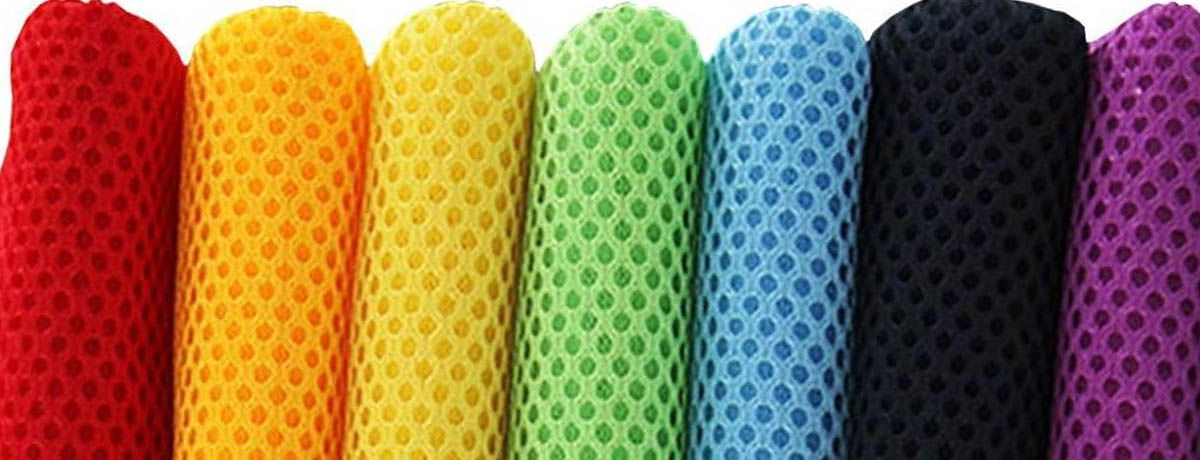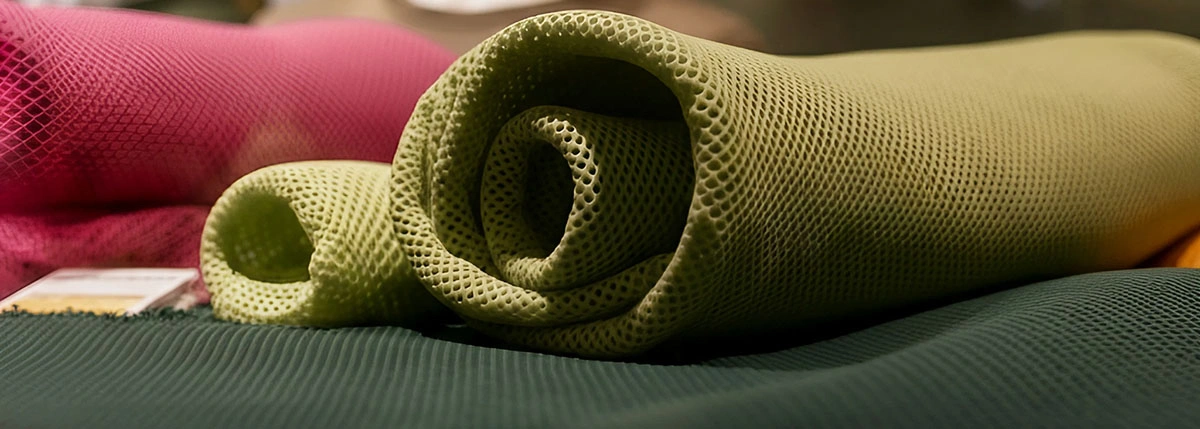Foam Mesh Fabric: A Comprehensive Guide

Foam mesh fabric is revolutionizing the textile and garment manufacturing industries. Known for its lightweight, breathable properties, this innovative material has gained popularity across activewear, uniforms, fashion, and even sustainable clothing lines. But what makes foam mesh fabric such a game-changer? And how can garment manufacturers and textile traders leverage its benefits to stay ahead in a competitive market?
Foam sandwich mesh is a versatile material suitable for various applications, such as spacers, ventilators, and linings for bags, seats, and cushions.
This blog dives deep into the world of foam mesh fabric, exploring its properties, benefits, innovations, and practical applications. Whether you’re a garment manufacturer seeking cutting-edge materials or a textile wholesaler looking to expand your catalog, you’ll discover everything you need to know to make informed decisions.
What is Foam Mesh Fabric?

Foam mesh fabric is a specialized type of textile characterized by its open, breathable structure often made with synthetic materials like polyester or nylon. Foam sandwich mesh is a specific type of foam mesh fabric known for its versatility and adaptability in various applications, such as spacers, ventilators, and linings for bags, seats, and cushions.
Key Properties: Moisture
-
Breathability: The open structure of foam mesh allows air circulation, making it ideal for applications requiring ventilation.
-
Lightweight: Despite its durability, foam mesh is impressively lightweight, ensuring comfort in garments.
-
Moisture-Wicking: Many foam mesh fabrics are designed to wick moisture away from the skin, enhancing comfort during physical activities.
-
Flexibility: The material has a natural stretch, allowing free movement, and making it suitable for activewear and uniforms.
Common Uses: Suitable Applications
-
Activewear such as sports jerseys and gym wear.
-
Uniforms requiring durability and ventilation (e.g., healthcare and hospitality sectors).
-
Design Features in footwear, bags, and accessories.
-
Specialized Fashion Garments due to its textural and visual appeal.
Benefits of Foam Mesh Fabric in Garment Manufacturing
Why are manufacturers and designers increasingly turning to foam mesh? Here are some game-changing benefits:
-
Enhanced Comfort
Foam mesh's breathable and moisture-wicking properties make it a perfect choice for applications where user comfort is paramount, including athletic apparel and uniforms.
-
Durability and Longevity
Its synthetic composition offers long-lasting performance, resistant to wear and tear from daily use or rigorous activity.
-
Aesthetic Options
Available in a wide variety of colors, finishes, and textures, foam mesh can add visual appeal to garments while maintaining functionality.
-
Cost-Effectiveness
Foam mesh is often more affordable compared to other performance fabrics, making it a budget-friendly choice for large-scale manufacturing.
-
Sustainability
Foam mesh is increasingly produced using eco-conscious methods, making it a strong candidate for sustainable fashion—a topic we’ll explore further below.
Understanding the Different Types of Foam Mesh Fabric
Not all foam mesh is created equal. Here’s an overview of the most commonly used types:
3.1 Spacer Mesh
Spacer mesh is known for its breathable properties and is often used in applications requiring ventilation, such as in sports equipment and outdoor gear.
3.2 Ventilator Mesh
Ventilator mesh is designed to allow air flow while providing support. It is commonly used in medical devices and automotive seating.
3.3 Lining Mesh
Lining mesh is typically used as an inner layer in bags, shoes, and apparel to provide structure and durability.
3.4 Cushion Mesh
Cushion mesh offers padding and comfort, making it ideal for use in cushions, mattresses, and upholstered furniture.
3.5 Foam Sandwich Mesh
Foam sandwich mesh is a versatile material suitable for various applications, such as spacers, ventilators, and linings for bags, seats, and cushions. It comes in different thicknesses and widths, and is available in neutral color options, making it adaptable for a wide range of projects. You can purchase foam sandwich mesh from specialized retailers and online stores.
Open-Cell Mesh
Known for its maximized airflow, this type of foam mesh is used in applications where breathability is critical, such as sportswear.
Micro-Mesh
This finer mesh type offers a softer feel, making it suitable for premium fashion garments or accessories.
Laminated Foam Mesh
Combining layers of foam for added durability, this type is used in heavy-duty applications like backpacks or uniform inserts.
Stretch Foam Mesh
Enhanced flexibility makes this option ideal for activewear or high-mobility garments.
Innovations and Trends in Foam Sandwich Mesh Fabric Technology
Recent advancements have given rise to exciting innovations in foam mesh fabric:
-
Eco-Friendly Production
Some manufacturers are adopting recycled polyester and energy-saving techniques to produce sustainable foam mesh.
-
Customizable Embellishments
Laser-cut designs and printed patterns allow foam mesh to be tailored for unique fashion or branding purposes.
-
Smart Textiles
Some foam mesh fabrics now incorporate technology like moisture sensors for sportswear or anti-bacterial coatings for healthcare uniforms.
Working with Foam Mesh Fabric
Foam mesh fabric is a versatile material that extends beyond garment manufacturing into various other applications, including construction and gardening. When working with foam mesh fabric, it’s essential to consider factors such as thickness, size, and color to ensure it meets your specific needs.
Sourcing and Supply Chain Considerations for Textile Traders
For textile wholesalers, sourcing foam mesh fabric goes beyond quality—reliability and cost also come into play. Trusted suppliers should provide resources and recommendations related to insulation installation and mesh supplies. Here are some things to keep in mind:
-
Supplier Reputation
Work with trusted suppliers who can guarantee consistent product quality and delivery timelines.
-
Certifications
Ensure the fabric meets necessary safety and environmental certifications if targeting regulated industries.
-
Sample Testing
Always request samples to assess breathability, texture, and durability before committing to bulk purchases.
Tips for Evaluating Foam Mesh Fabric Quality
Garment manufacturers and traders should evaluate foam mesh fabric based on the following criteria:
-
Mesh Density
Determine whether the fabric provides sufficient ventilation or structure, depending on its intended use.
-
Weight and Thickness
Check that the weight aligns with the garment's requirements—for example, lightweight for activewear, thicker options for accessories.
-
Durability Tests
Ensure the fabric withstands stretch, washing, and general wear and tear.
-
Moisture Management
Verify that the material effectively wicks away moisture, especially for active applications.
Case Studies: Successful Implementation of Foam Mesh Fabric
1. High-End Sportswear Brand
A sportswear company incorporated breathable, fast-drying foam mesh fabric into its latest line of athletic jerseys. The result? Increased customer satisfaction and a 25% sales boost in the quarter following the launch.
2. Sustainable Fashion Label
Leveraging foam mesh made from recycled materials, this eco-conscious brand reduced fabric waste and cut its carbon footprint by 20%. The line gained media attention and appreciation from environmentally conscious consumers.
3. Uniform Manufacturer
A major uniform supplier used foam mesh to develop lightweight, moisture-wicking workwear for healthcare and hospitality employees. Feedback noted a 30% improvement in comfort, leading to long-term contracts.
4. Innovative Designer Showcase
An internationally renowned fashion designer used foam mesh in an avant-garde runway collection, emphasizing its unique textural qualities. Industry buzz led to collaborations with multiple brands across multiple industries.
Future Outlook: The Role of Foam Mesh Fabric in Sustainable Fashion
The global drive for sustainability has positioned foam mesh as a key player in ethical and eco-friendly fashion. With manufacturers finding greener production methods for this versatile fabric, we could see its role expand to broader applications. Innovations like plant-based polymers could further reduce waste and open up even more opportunities for foam mesh to shine.
Conclusion
Foam mesh fabric stands out as a versatile and practical material suitable for a wide range of applications, from garment manufacturing to construction and gardening. Its breathable properties and ability to manage moisture make it an ideal choice for use in walls, floors, and ceilings. Available in bulk at wholesale prices, foam mesh fabric provides a cost-effective solution for customers requiring large quantities. Whether for construction, gardening, or other specialized uses, foam mesh fabric offers excellent results, making it a suitable choice for diverse projects.
Explore Foam Mesh Fabrics for Your Next Project
Foam mesh fabric is more than just a material—it’s a revolution in garment manufacturing and textile trading. With its unmatched versatility, durability, and sustainability, it offers immense potential across industries.
Interested in learning more? Our team of experts can help you source the right foam mesh fabric for your needs. Contact us today to get started!
